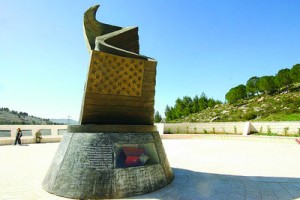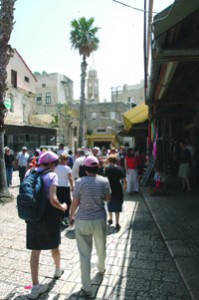Israeli Scene
Life + Style
Cut & Post

In Memoriam, In Israel
The next time you are in Israel, be sure to make a detour to the entrance of Jerusalem’s Arazim Park to pay your respects to a tragic moment in history—America’s history. Israel’s 9/11 memorial, dedicated last fall to the two nations’ shared commitment to peace, is the creation of award-winning artist Eliezer Weishoff and is the only 9/11 monument in the world outside New York that lists the name of each and every victim.
The soaring 30-foot sculpture, surrounded by benches inviting reflection, takes the shape of a waving American flag morphing into a flame.
The memorial was a project of the Jewish National Fund (www.jnf.org) and funded by the Bronka Stavsky Rabin Weintraub Trust and New Yorker Edward Blank, who lost his wife a few days before 9/11. —Deborah Fineblum Raub

Photo by Isranet
To Preserve and Protect
Akko, on Israel’s northern coast, was a famous Crusader port city during the Middle Ages and was rebuilt in the 17th to 20th centuries by the Ottomans. UNESCO has declared Akko’s Old City a World Heritage site, ranking it with the Grand Canyon and Egypt’s pyramids.
“The whole city is a laboratory for conservation studies,” says Shelley-Anne Peleg, director of the International Conservation Center (www.antiquities.org.il/akko), which opened in May in an Ottoman building that rests on Crusader foundations.
The center, under the auspices of the Israel Antiquities Authority in collaboration with the Old Akko Development Company and Akko Municipality, aims to meet Israel’s need for trained conservators by working with universities in the country and abroad. In addition, a six-month hands-on program, Saving the Stones, offers college graduates from abroad an introduction to conservation; each student also works on a personal project in Akko.
Rome’s mayor, Giovanni Alemanno, is funding the center with the Dan David Prize money—which is administered by Tel Aviv University—that his city received; the Italian Embassy in Israel and the Italian Culture Ministry are providing consultancy and professional training. —Esther Hecht
Repentance—Via E-mail, Facebook or Twitter
In 2009, along with 15,000 others, I observed the 10 days of repentance between Rosh Hashana and Yom Kippur by answering a series of e-mail questions from 10Q; for example, “Is there something you wish you had done differently this past year?” 10Q didn’t care if my comments were long or short, crass or deep, or if I chose to remain anonymous in the online community where answers were posted.
“We tried to let people tap back into tradition,” says Ben Greenman, who launched the project with two cocreators in 2008, “but without feeling like they have to pass an entrance exam.”
The 10Q Web site (www.renewyear.com) is spare and idiot-proof. At the end of 10 days, all answers are locked in a virtual vault that reopens three days before the next Rosh Hashana. That is when participants receive an e-mail containing last year’s written record. Then the 10 questions begin arriving again, via e-mail, Facebook or Twitter.
“It comes from a deeply Jewish place,” explains Nicola Behrman, a 10Q cocreator, “but it’s an experience anyone can have. I’m proud of the fact that we have Christians in Texas and atheists in Ireland telling us they got so much enjoyment and solace out of this experience.” —Robin Chotzinoff
Art Goes En Plein Air in Sderot
Using bomb shelters as canvases, a group of top international graffiti artists recently brought some color to the rocket-battered Israeli town of Sderot. Spray cans in hand, the artists translated their solidarity with local residents into bold geometric murals depicting everything from flowering gardens to an imaginary Israel-New York subway line.
“Graffiti as a medium for public art is pretty cool. It’s a fast way to get your message across on a large space,” said Sarah Brega, one of the artists who visited as part of a group called Artists 4 Israel (www.artists4israel.org). “The people of Sderot loved the graffiti…. It was definitely something new [for them].
“I only hope,” she added, “that we encouraged the people there to realize they can beautify their own city just like we did. That they should take something ugly, like these bomb shelters that sadly must be there, and turn them into something beautiful to look at.”
A photography exhibit of the artists’ work in Sderot—as well as murals they created in Kiryat Gat, Tel Aviv, Jerusalem and Herzliya—was later held at New York’s Eden Gallery (www.eden-gallery.com). —Dina Kraft
Clear Skies in Israel’s Economic Forecast
Wondering how Israel is faring during the global economic crisis? The answer is, not too badly. For a quick checkup of the Jewish state’s vital financial stats, consult the Central Bureau of Statistics Web site (www.cbs.gov.il). There, you will learn that:
—unemployment for the first quarter of 2010 was 7.2 percent (compared to 9.7 percent in the United States for the same period)
—number of job vacancies in May 2010 was 54,000
—the average monthly wage is $2,227
—Israel’s economy expanded 3.6 percent in the first quarter of 2010 (and is predicted to grow by between 3.5 to 3.9 percent this year)
—exports comprise almost 50 percent of Israel’s gross domestic product
—population at the end of April 2010 was 7,588,400
In other economic news, in May, Israel was unanimously voted into the 31-member-nation Organization for Economic Co-operation and Development, which Finance Minister Yuval Steinitz described as “a badge of honor.” In October, the OECD’s tourism committee will hold its first-ever annual conference outside of its headquarters in Paris, this time meeting in Jerusalem. —Libby Barnea
Jews, Friers For Frying
As they celebrate the 150th anniversary of their most famous national dish, the English may want to say a word of thanks to the meal’s Jewish inventors.
“Fish and chips, which everyone thinks of as very English, is, in fact, Sefardic Jewish,” claimed Nigella Lawson, the British celebrity cooking show host, at the March reopening of the London Jewish Museum.
Along with several prominent colleagues, Lawson, who is Jewish, has spent 2010 advancing the theory that fish and chips—
or at least its aquatic component—came to England in the 16th century, brought by Jews expelled from Portugal.
The dish’s uncertain beginnings have emerged as a topic of conversation since the United Kingdom’s National Federation of Fish Friers proclaimed 2010 to be the meal’s 150th anniversary, citing 1860 as the first time fish and chips were sold in combination.
Jewish refugees may have been the first to fry their fish in batter, Lawson has argued—a claim seemingly backed up by the Independent newspaper, which quoted American President Thomas Jefferson describing the “fried fish in the Jewish tradition” he sampled during a visit to England in the late 18th century. —Nathan Burstein










 Facebook
Facebook Instagram
Instagram Twitter
Twitter
Leave a Reply